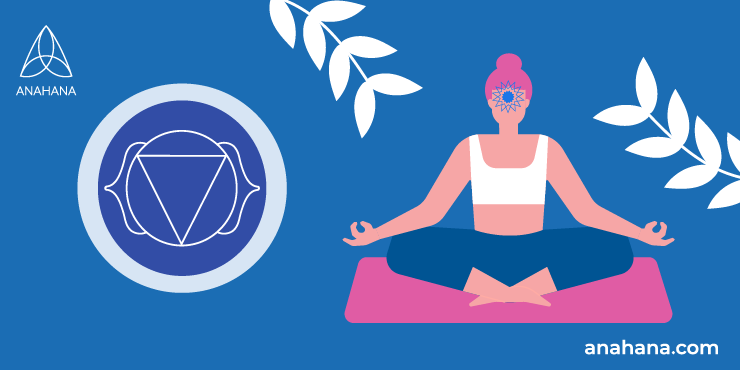
Table of Contents
Explore the significance of the indigo chakra and its impact on intuition and spiritual awareness. This article offers practical insights on activating and balancing this energy center, promoting clarity and inner wisdom. Elevate your spiritual journey with a straightforward guide to harnessing the transformative energy of the indigo chakra.
Indigo Chakra
The Third Eye chakra, also known as the indigo chakra, Ajna chakra, or the sixth chakra, plays a significant role in the human energy system. The chakra is located at the center of the forehead, just above the eyebrows, affecting the eyes, sinuses, pituitary gland, and brain.
The Third Eye chakra color indigo (often called royal blue or deep purple) is responsible for inner vision, intuition, and the ability to transcend polarity and access a state of open awareness or pure consciousness. The indigo chakra color represents the seat of higher human consciousness and spiritual connection.
Function of the Indigo Chakra
The indigo chakra is responsible for inner vision, intuition, and foresight. It bridges the physical and spiritual realms, allowing you to access deeper truth and inner wisdom.
The indigo chakra is associated with the pineal gland, which regulates our sleep patterns and produces melatonin. The indigo chakra meaning relates to self-responsibility, which includes accountability for your life, following the soul's path and needs, and trusting your intuition.
A balanced indigo chakra provides a deep sense of inner knowing and a strong connection to spirit guides.
It is said to transcend the limitations of the physical senses and help access the sixth sense for spiritual development. Balancing the indigo chakra is essential to achieve spiritual and emotional balance.
Signs of an Unbalanced Third Eye Chakra
When the Ajna chakra is blocked, underactive, or overactive, you may experience poor physical or mental health.
Overactive Third Eye Chakra
An overactive indigo chakra can lead to an excessive focus on the spiritual world at the expense of the physical world. Signs of an overactive Third Eye Chakra include:
-
Obsessive thoughts
-
Difficulty concentrating or staying focused
-
Headaches or migraines
-
Hallucinations or delusions
-
Paranoid thoughts or behaviors
-
Feeling disconnected from reality
Underactive Third Eye Chakra
An underactive chakra is not functioning optimally, leading to a lack of energy flow and balance in that particular energy center. Some symptoms of an underactive indigo chakra include:
-
Difficulty making decisions or lack of clarity
-
Difficulty with visualization or imagination
-
Lack of intuition or psychic abilities
-
Difficulty accessing higher states of consciousness
-
Lack of spiritual connection or understanding
Blocked Indigo Chakra
A blocked Third Eye Chakra occurs when there is a blockage in the flow of energy within the chakra. Some symptoms include:
-
Insomnia or sleep disorders
-
Poor memory, cognitive issues, and executive function challenges
-
Anxiety or depression
-
Eye strain or vision problems
-
Inability to connect with your intuition or inner guidance
-
Feeling stuck or unable to move forward in life
-
Difficulty connecting with spirituality or feeling a sense of purpose
What Does an Open Indigo Chakra Feel Like?
Opening the Third Eye can lead to heightened sensitivity, intuition, and emotional balance. You may be able to sense other people’s feelings from a distance and experience pressure or tingling in the middle of the forehead. Your creative visualization skills may improve, making manifesting your desired future into reality easier.
How to Balance Indigo Chakra

Balancing the indigo chakra is essential for achieving emotional and spiritual balance. Here are some effective ways to balance the indigo chakra:
Meditation
Chakra Meditation is a powerful tool for balancing the indigo chakra. By quieting the mind and focusing on the breath, we can calm the mind and open the Third Eye. Here are some steps to a basic Ajna meditation:
-
Find a quiet and comfortable place where you won't be disturbed.
-
Close your eyes and focus on your breath. Take a few deep breaths to relax and clear your mind.
-
Visualize the indigo chakra at the center of your forehead.
-
As you inhale, imagine a bright, indigo light entering your body and filling your Third Eye chakra.
-
Hold your breath for a few seconds and visualize the energy flowing through your chakra, cleansing and balancing it.
-
Stay in this state of meditation for as long as you feel comfortable.
-
When you're ready to finish your meditation, take a few deep breaths, stretch your body, and open your eyes.
Yoga Asanas
Practicing yoga poses that stimulate the indigo chakra and balance its energy include:
-
Child's Pose (Balasana): This pose helps calm the mind and relieve stress, promoting inner peace.
-
Downward Facing Dog (Adho Mukha Svanasana): This pose increases blood flow to the head and can help stimulate the Third Eye chakra.
-
Eagle Pose (Garudasana): This pose helps increase focus and concentration while opening up the shoulders and hips.
-
Lotus Pose (Padmasana): This traditional seated meditation posture can help calm the mind and promote inner peace.
Indigo Chakra Stones
A dark blue or purple gemstone like Lapis Lazuli, Purple Fluorite, and Amethyst can help balance chakra. You can use healing stones by carrying them with them, wearing them as jewelry, or placing them on the forehead during meditation to activate the sixth sense and strengthen the deep inner knowing.
Aromatherapy
Essential oils like frankincense, sandalwood, and patchouli can stimulate the indigo chakra and promote spiritual clarity.
Wear Indigo Clothing
Wearing indigo clothing is believed to help stimulate and balance the Third Eye chakra. The indigo color is associated with this chakra, and wearing apparel of this color can help to align and activate this energy center.
Shadow Work
Shadow work is a spiritual practice for healing the third-eye chakra. To engage in shadow work for the indigo chakra, you should reflect on your fears, limiting beliefs, and negative thought patterns that may be blocking your intuition and inner vision.
To begin, journaling about experiences or memories that have hindered the connection to your inner vision is a helpful practice.
This may include exploring negative self-talk, past traumas, or limiting beliefs. Reflecting on these experiences and how they may affect the ability to trust intuition and inner guidance is important.
Cultivating self-awareness through mindfulness and meditation can also aid in shadow work for the third-eye chakra. It is important to approach this work with patience and self-compassion, as healing and balancing the third-eye chakra is a process that requires time and effort.
Takeaway
The Third Eye chakra is essential for overall well-being, including emotional, mental, and spiritual health. When this energy center is balanced, you experience clarity of thought, spiritual connection, and intuition.
However, an imbalanced indigo chakra can lead to physical, emotional, and spiritual symptoms. Fortunately, meditation, yoga, and more can promote a healthy indigo chakra, which also includes chakra stones and crystals.
By balancing this chakra, you can deepen your self-awareness, strengthen your intuition, and connect with your consciousness, leading to new spiritual growth and self-discovery.
Frequently Asked Questions
What chakra is indigo in color?
The indigo color is associated with the Ajna Chakra, commonly known as the Third Eye Chakra or the Sixth Chakra.
This energy center, located at the center of the forehead, is crucial for inner vision and intuition. The indigo chakra color symbolizes the bridge between the physical and spiritual realms, enhancing psychic abilities and deeper levels of consciousness.
What is the spiritual significance of the color indigo?
Indigo represents a deep connection to the spiritual world. In the context of chakras, the indigo color, linked to the Third Eye Chakra, reflects the ability to transcend polarity and achieve unity.
It's seen as a color that fosters self-awareness, spiritual clarity, and the development of mystical experiences. Indigo relates to the left and right hemispheres of the brain, balancing logical and intuitive thinking.
What are the powers of the Ajna chakra?
The Ajna Chakra, associated with the indigo color, enhances intuition, psychic abilities, and inner wisdom.
It is considered one of the most important chakras in developing psychic powers and connecting with universal consciousness. This chakra helps unlock deep inner knowing and access deeper truths beyond the physical senses.
References
https://www.researchgate.net/publication/338895528_Psychological_Significance_of_the_Chakras
https://www.researchgate.net/publication/342562977_A_Brief_History_of_the_Chakras_in_Human_Body
https://books.google.com/books/about/Chakras.html?id=810oDwAAQBAJ
https://health.clevelandclinic.org/chakras
https://www.fitsri.com/articles/chakra-colors-meaning-science
https://www.siddhiyoga.com/yoga/practice/chakras/chakra-colors
Disclaimer
The contents of this article are provided for informational purposes only and are not intended to substitute for professional medical advice, diagnosis, or treatment. It is always recommended to consult with a qualified healthcare provider before making any health-related changes or if you have any questions or concerns about your health. Anahana is not liable for any errors, omissions, or consequences that may occur from using the information provided.

By: Meriah McCauley
Meriah McCauley is a leading voice in holistic healing, known across North America for her expertise in chakra balancing, spiritual alignment, and energy-based wellness. Her work bridges the art and science of mind-body healing, shaped through years of study, practice, and mentorship. Meriah deepened her understanding of spiritual anatomy and the chakra system under the guidance of her guru, Dr. Don Stapleton, during her immersive training in Costa Rica. She later earned her Master’s degree in Psychology from Columbia University, specializing in Spirituality and the Mind–Body connection, which continues to influence her integrative approach. Today, she supports individuals and practitioners through coaching, yoga teacher trainings, chakra-focused education, and Holotropic Breathwork for personal transformation. Meriah is dedicated to helping others develop emotional clarity, energetic balance, and spiritual resilience—and she remains committed to guiding anyone seeking a deeper, more meaningful connection with themselves.